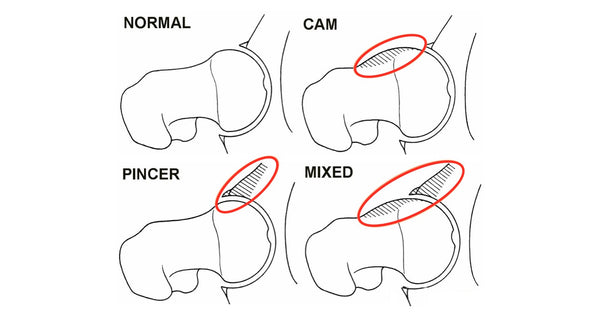Femoral Acetabular Impingement (FAI)
There's a myth that FAI cannot be treated effectively without surgery.
Impingement occurs when the ball shaped head of the femur rubs abnormally or pinches (impinges) the acetabular socket.
Damage to the hip joint can occur to the articular or labral cartilage.
Impingement
People with FAI usually present with pain (or sometimes a dull ache) in the inguinal/groin area and sometimes more toward the outside of the hip.
Sharp stabbing pain may occur with turning, twisting, and squatting.
FAI occurs because the hip bones do not form normally during childhood in the growing years.
The deformity of a CAM bone spur, pincer bone spur, or both, leads to joint damage and pain. When the hip bones are shaped abnormally, there is little that can be done to prevent FAI.

Types of FAI - "Mixed" is the most common
Types of FAI Mechanism
- Cam deformity - An excess of bone along the neck of the proximal femur
- Pincer deformity - Due an excessively deep socket or an abnormal tilt of the acetabular socket
- A mixture of the preceding two forms (most common scenario).
The result of any of these deformities is increased friction/catching between the acetabular cup and femoral head which may result in pain and loss/reduction of hip function.
FAI and Trigger Points
There's a myth that FAI cannot be treated effectively without surgery.
However, the reality is that we can often drastically improve the function of the hip through appropriate intervention with the muscles that control the hip joint - and yes, we are referring here to clients who have radiologic signs of femoral acetabular impingement.
Holding Patterns
Reprograming the muscles to work correctly means targeting the holding patterns relating to the FAI.
The treatment protocols usually include the treatment of trigger points in the glutes, hip adductors, iliopsoas, and TFL.
Typically we find that the tonicity housed in the adductor muscles is the key to a gluteus overload, and can be quite swiftly resolved by identifying and treating those trigger points.
Restrictions in hip extension are generally related to hip flexor attachment trigger points in quadratus femoris.
Once these trigger points have been successfully deactivated, FAI patients will often report an immediate and very noticeable improvement in movement.
Summary
So, whilst trigger point therapy is absolutely not a cure for FAI, it may often be applied to provide tremendous relief by addressing the holding patterns of the hip and restoring correct muscle function.
This is also true (maybe even more so) for clients who have undergone surgery. In these cases, the same treatment protocols may be applied post surgery as part of the latter term rehabilitation process.
Failure to address the trigger points and hip holding patterns may the lead to a continuation of at least some of the symptoms, even after "successful" surgery.
Finally, it's worth noting the importance of treating FAI as soon as it has been diagnosed. The longer painful symptoms go untreated, the more damage FAI can cause in the hip.
Stuart Hinds is the author of "The NAT Hip" that will be available in both print and digital editions in February 2017.
Find a Trigger Point Professional in your area
This trigger point therapy blog is intended to be used for information purposes only and is not intended to be used for medical diagnosis or treatment or to substitute for a medical diagnosis and/or treatment rendered or prescribed by a physician or competent healthcare professional. This information is designed as educational material, but should not be taken as a recommendation for treatment of any particular person or patient. Always consult your physician if you think you need treatment or if you feel unwell.
About Niel Asher Education
Niel Asher Education (NAT Global Campus) is a globally recognised provider of high-quality professional learning for hands-on health and movement practitioners. Through an extensive catalogue of expert-led online courses, NAT delivers continuing education for massage therapists, supporting both newly qualified and highly experienced professionals with practical, clinically relevant training designed for real-world practice.
Beyond massage therapy, Niel Asher Education offers comprehensive continuing education for physical therapists, continuing education for athletic trainers, continuing education for chiropractors, and continuing education for rehabilitation professionals working across a wide range of clinical, sports, and wellness environments. Courses span manual therapy, movement, rehabilitation, pain management, integrative therapies, and practitioner self-care, with content presented by respected educators and clinicians from around the world.
Known for its high production values and practitioner-focused approach, Niel Asher Education emphasises clarity, practical application, and professional integrity. Its online learning model allows practitioners to study at their own pace while earning recognised certificates and maintaining ongoing professional development requirements, making continuing education accessible regardless of location or schedule.
Through partnerships with leading educational platforms and organisations worldwide, Niel Asher Education continues to expand access to trusted, high-quality continuing education for massage therapists, continuing education for physical therapists, continuing education for athletic trainers, continuing education for chiropractors, and continuing education for rehabilitation professionals, supporting lifelong learning and professional excellence across the global therapy community.

Continuing Professional Education
Looking for Massage Therapy CEUs, PT and ATC continuing education, chiropractic CE, or advanced manual therapy training? Explore our evidence-based online courses designed for hands-on professionals.



















